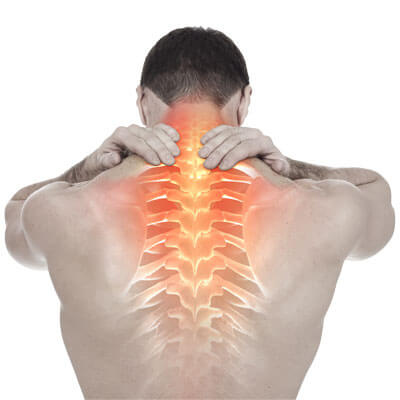Mid-Back and Shoulder Pain
 Thoracic Spine Mobility
Thoracic Spine Mobility
When the thoracic spine is operating optimally, it allows you to move in basically all directions. It’s built for mobility and movement such as bending and twisting. It’s designed for flexion, extension, and rotation.Today’s sedentary lifestyle lends itself to reduced thoracic spine mobility. A lack of thoracic spine mobility means that the lumbar spine, pelvis, shoulders and surrounding muscles could all compensate to help pick up the mobility lost in T-Spine. Long term, those compensations can absolutely lead to injury. Those chronic neck, upper back and shoulder problems could actually be from a lack of mobility in the thoracic spine.
Bicep tendonitis
The long head of bicep (LHB) tendon can become inflamed and painful following acute trauma or from overuse. Inflammation can also occur in the sheath that surrounds the LHB tendon, this is known as bicipital tenosynovitis. Tendinitis can also affect the distal tendon but these injuries normally arise following incidences where the elbow is suddenly or repeatedly bent or straightened against resistance.
Frozen shoulder
Frozen Shoulder, clinically known as Adhesive Capsulitis, is a condition that involves contracture of the shoulder capsule causing painful and limited movement. Patients with Frozen Shoulder usually experience progressive onset of pain and gradual decrease in range of motion that can take months to years to subside. Frozen Shoulder is one of the most common shoulder conditions and affects up to 5% of the population, generally in people aged 40-60 and is more common in women than men. So far there is still no known cause as to how Frozen Shoulder begins. What is known is that certain medical conditions can increase the risk of having Frozen Shoulder.
Glenohumeral dislocation/subluxation
The shoulder joint, also known as the glenohumeral joint, is the most mobile joint in the body, owing mainly to its unique anatomical structure which includes a very shallow socket. Unfortunately, it is also the most frequently dislocated joint in the human body. The joint is kept in place or stabilized by a combination of bone, ligaments and muscles, which all have an important part to play in shoulder stability. The bony part of the joint socket is very shallow, so it is important that all these structures are working well to prevent the joint from dislocating. A shoulder subluxation refers to a partial dislocation of the shoulder joint. This occurs when the humerus partly comes out of the glenoid socket in the shoulder. Because the shoulder moves in several directions, the dislocation can be anterior, posterior or inferior. This is also true for subluxations.
Rotator cuff lesions
The rotator cuff is made up of four muscles and their tendons that help move and stabilize the shoulder joint. A rotator cuff tear is a lesion of the tendon that attaches the muscle from the shoulder blade to the head of the humerus. Most tears occur in the supraspinatus tendon, however other areas of the rotator cuff may also be involved. It is common for these tendons to tear as people get older. The tendon tear usually begins in a degenerate tendon that may fray and split. As the tendon damage progresses the tendon can tear. There are different causes of rotator cuff lesions such as; repetitive shoulder movements in sports or jobs, overloading of the joint by heavy lifting, a trauma like a fall and general wear and tear with poor posture and age.
Subacromial bursitis and impingement syndrome
Subacromial bursitis, commonly caused by shoulder impingement is the most common type of shoulder bursitis. The rotator cuff muscles function to keep the ball of the shoulder centered in it’s socket when the arm is raised above head. External shoulder impingement occurs when the ball of the shoulder moves abnormally upward and compresses structures like the subacromial bursa and rotator cuff tendons against the acromion above. Shoulder impingement is the most widely accepted cause of shoulder bursitis. Rotator cuff tendinopathy rarely exists without some form of shoulder bursitis. An acute overload of overhead work such as an increase in painting, throwing or weight lifting can cause abnormal swelling of the subacromial bursa and rotator cuff tendons.
Thoracic outlet syndrome
Thoracic outlet syndrome (TOS) is the general term used to describe a condition caused when the nerves and blood vessels below your neck are compressed between the collarbone and the first rib. There are 3 types of TOS; neurogenic, vascular or nonspecific.
The cause of compression can vary but include trauma, poor posture with rounded shoulders and a forward head position, anatomical differences like the presence of a cervical rib and the pressure on the joints like when carrying a heavy backpack.
The symptoms can vary depending on which structure is compressed but will most commonly include numbness or tingling in the arm or fingers, pain in the shoulder, arm or hand and weakness in the hand.
Scapular dysfunction
Scapular dysfunction, also known as scapular dyskinesis, is the abnormal function or mobility of the scapula. It occurs often with injuries that creates inhibitions or disorganization of proper movement patterns in the scapular stabilizing muscles. The trapezius, rhomboids and serratus anterior must be properly synchronized in their action for smooth scapular motion during arm movements. The majority of scapular dysfunction cases are the result of the loss of muscular coordination causing the medial border of the scapula to appear more prominent than the opposite side also called “winged scapula” or “winging” of the scapula. It is often associated with pain, decreased range of motion and strength at the shoulder, tenderness around the scapula, and a snapping sound with shoulder movement.
Ready to get started?
Contact us today to make an appointment.
CONTACT US »

Mid-Back and Shoulder Pain Treatment Spine & Sports Injury Center | (617) 247-2300
 Thoracic Spine Mobility
Thoracic Spine Mobility
